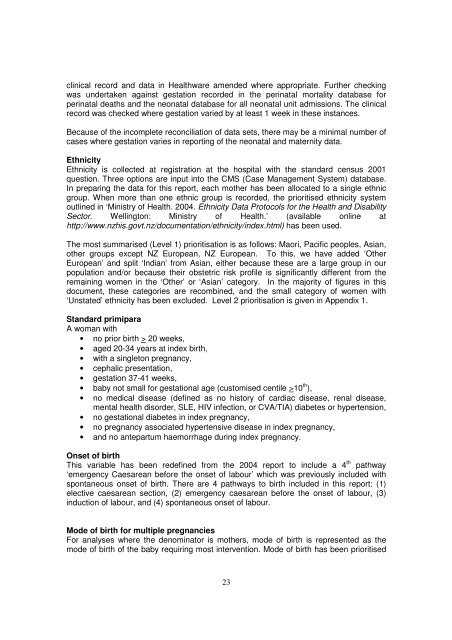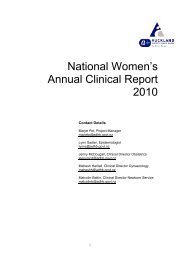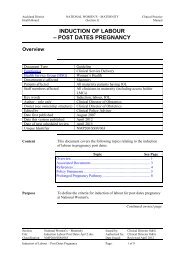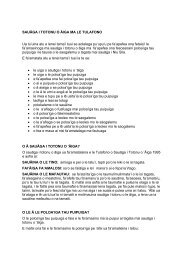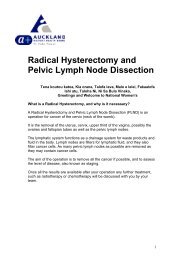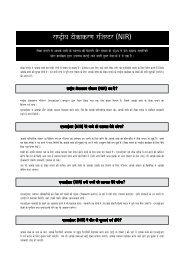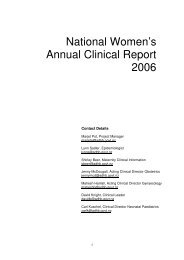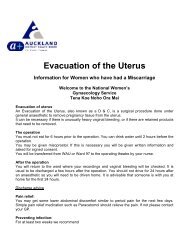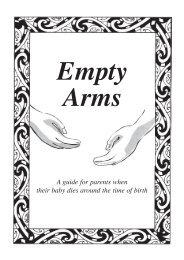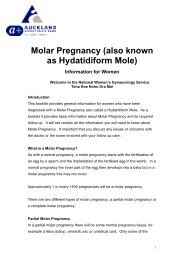2005 - National Women's Hospital - Auckland District Health Board
2005 - National Women's Hospital - Auckland District Health Board
2005 - National Women's Hospital - Auckland District Health Board
Create successful ePaper yourself
Turn your PDF publications into a flip-book with our unique Google optimized e-Paper software.
clinical record and data in <strong>Health</strong>ware amended where appropriate. Further checking<br />
was undertaken against gestation recorded in the perinatal mortality database for<br />
perinatal deaths and the neonatal database for all neonatal unit admissions. The clinical<br />
record was checked where gestation varied by at least 1 week in these instances.<br />
Because of the incomplete reconciliation of data sets, there may be a minimal number of<br />
cases where gestation varies in reporting of the neonatal and maternity data.<br />
Ethnicity<br />
Ethnicity is collected at registration at the hospital with the standard census 2001<br />
question. Three options are input into the CMS (Case Management System) database.<br />
In preparing the data for this report, each mother has been allocated to a single ethnic<br />
group. When more than one ethnic group is recorded, the prioritised ethnicity system<br />
outlined in ‘Ministry of <strong>Health</strong>. 2004. Ethnicity Data Protocols for the <strong>Health</strong> and Disability<br />
Sector. Wellington: Ministry of <strong>Health</strong>.’ (available online at<br />
http://www.nzhis.govt.nz/documentation/ethnicity/index.html) has been used.<br />
The most summarised (Level 1) prioritisation is as follows: Maori, Pacific peoples, Asian,<br />
other groups except NZ European, NZ European. To this, we have added ‘Other<br />
European’ and split ‘Indian’ from Asian, either because these are a large group in our<br />
population and/or because their obstetric risk profile is significantly different from the<br />
remaining women in the ‘Other’ or ‘Asian’ category. In the majority of figures in this<br />
document, these categories are recombined, and the small category of women with<br />
‘Unstated’ ethnicity has been excluded. Level 2 prioritisation is given in Appendix 1.<br />
Standard primipara<br />
A woman with<br />
• no prior birth > 20 weeks,<br />
• aged 20-34 years at index birth,<br />
• with a singleton pregnancy,<br />
• cephalic presentation,<br />
• gestation 37-41 weeks,<br />
• baby not small for gestational age (customised centile >10 th ),<br />
• no medical disease (defined as no history of cardiac disease, renal disease,<br />
mental health disorder, SLE, HIV infection, or CVA/TIA) diabetes or hypertension,<br />
• no gestational diabetes in index pregnancy,<br />
• no pregnancy associated hypertensive disease in index pregnancy,<br />
• and no antepartum haemorrhage during index pregnancy.<br />
Onset of birth<br />
This variable has been redefined from the 2004 report to include a 4 th pathway<br />
‘emergency Caesarean before the onset of labour’ which was previously included with<br />
spontaneous onset of birth. There are 4 pathways to birth included in this report: (1)<br />
elective caesarean section, (2) emergency caesarean before the onset of labour, (3)<br />
induction of labour, and (4) spontaneous onset of labour.<br />
Mode of birth for multiple pregnancies<br />
For analyses where the denominator is mothers, mode of birth is represented as the<br />
mode of birth of the baby requiring most intervention. Mode of birth has been prioritised<br />
23


